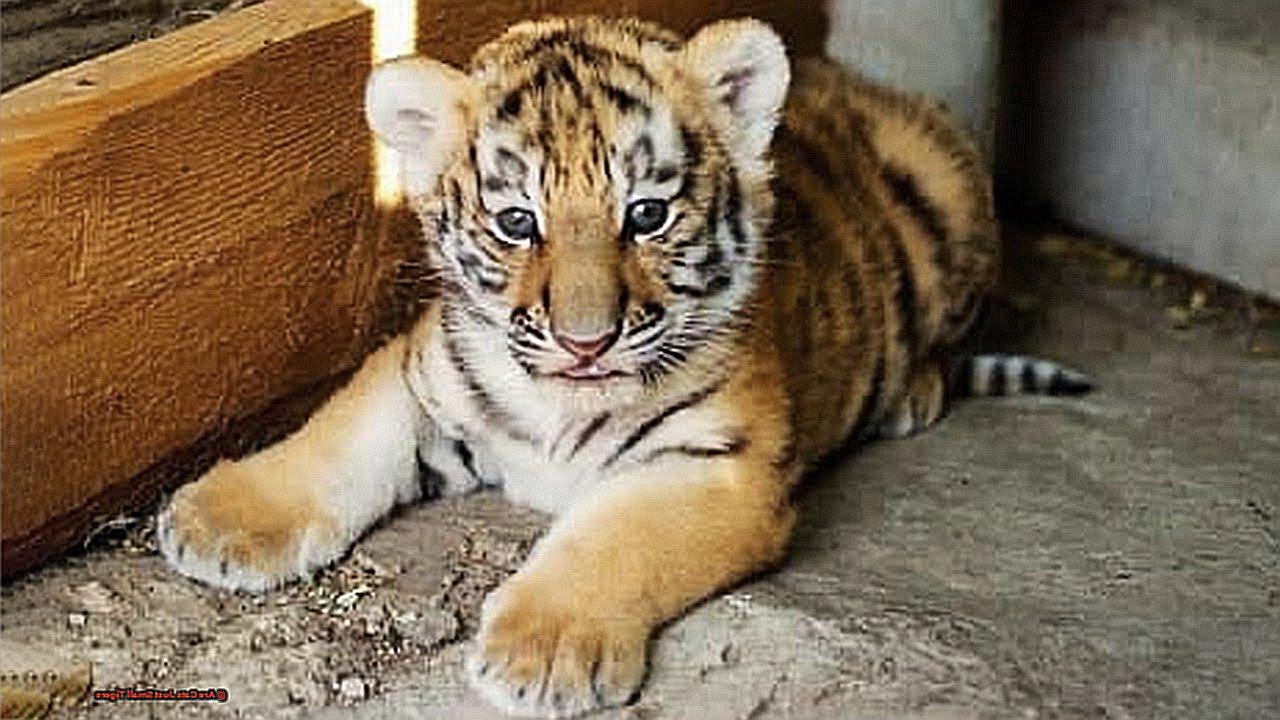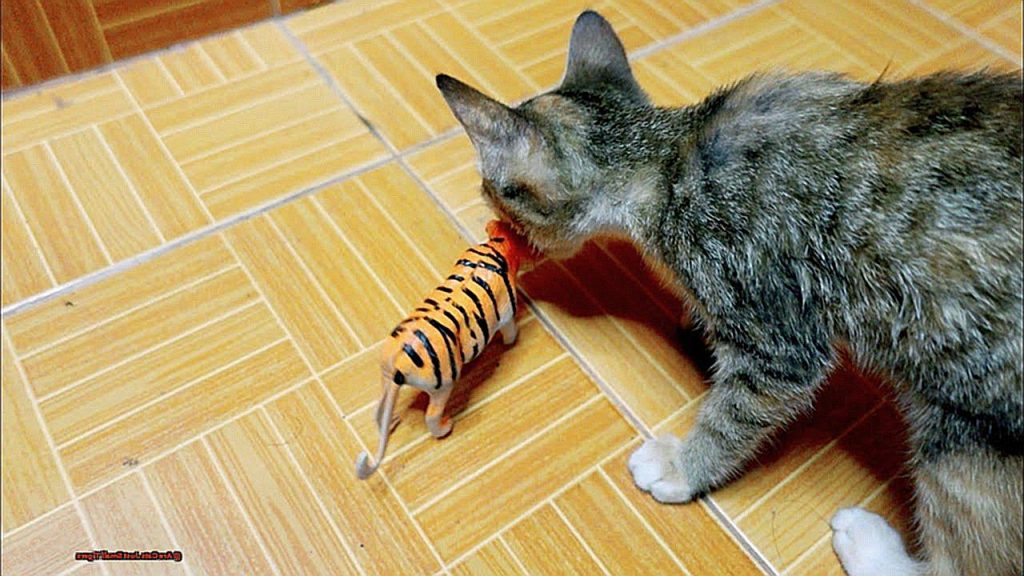Meow and roar, two distinct sounds that seem worlds apart.
Contents
But what if I told you that cats and tigers have more in common than meets the eye? As a self-proclaimed cat enthusiast and wildlife lover, I have often found myself wondering, are cats simply miniature tigers?
From their physical features to their behaviors, these two feline species share striking similarities that cannot be ignored. So let’s put on our safari hats and dive into the wild world of cats and tigers to uncover the truth behind this question.
Grab your purring pet or imagine yourself in the heart of the jungle as we embark on this exciting journey together.
Are Cats Just Small Tigers?
While it may seem like an odd question, there is actually a fascinating relationship between these two animals that goes beyond their physical similarities. In this section, we will explore the connection between cats and tigers and uncover the reasons behind their shared traits and differences.

Evolutionary History
Cats and tigers belong to the Felidae family, which includes all species of cats. This means that they share a common ancestor and have evolved from it over millions of years. However, while domestic cats have been domesticated for thousands of years, tigers remain wild animals that have retained their natural instincts and behaviors.
Physical Similarities
One of the most noticeable similarities between cats and tigers is their physical appearance. Both have sharp claws that can retract, keen eyesight, and agile bodies. These features are essential for their hunting abilities, allowing them to capture prey with precision and agility.
Behavioral Similarities
Cats and tigers also share many behavioral traits. They are skilled hunters, using similar techniques to catch their prey. They are also solitary animals that mark their territory with urine and scratches. This territorial behavior can also be seen in domestic cats, who can be fiercely protective of their home and may show aggression towards unfamiliar animals.
Differences between Cats and Tigers
Despite their similarities, there are also significant differences between cats and tigers. The most obvious one being their size – while tigers can weigh up to 660 pounds, domestic cats typically weigh around 10 pounds. This size difference is due to millions of years of evolution and adaptation to different environments.
Another notable difference is their social behavior. While domestic cats can be trained to be socialized with humans and other animals, tigers are solitary creatures that prefer to live alone in their natural habitat.
Importance of Understanding the Connection
Understanding the connection between cats and tigers is crucial for cat owners. This knowledge can help them better understand their pets’ behaviors and needs, as well as appreciate the fascinating evolutionary history of these animals. It also highlights the unique characteristics and adaptations of both species, making them even more intriguing creatures.
Physical Characteristics of Cats and Tigers
Let’s start with the basics – both cats and tigers belong to the same scientific family, Felidae. This includes all species of cats, from the smallest domestic kittens to the largest tigers. However, they belong to different subfamilies – domestic cats belong to Felinae, while tigers belong to Pantherinae.
Despite this difference, cats and tigers share many physical characteristics. One of the most notable is their retractable claws. This unique feature allows them to extend their sharp claws when needed for hunting or climbing and retract them when not in use. It also helps keep their claws sharp and protected from wear and tear.
Another shared feature is their flexible spines, which allow them to twist and turn with incredible agility. This flexibility comes in handy for both hunting and playtime.
Cats and tigers also have excellent eyesight and hearing, which helps them hunt prey in the wild. Their eyes are adapted for both day and night vision, with a reflective layer called the tapetum lucidum that enhances their ability to see in low light. Their ears also have a wide range of motion, allowing them to detect even the slightest movement of prey.
In terms of size, there is a significant difference between cats and tigers. Domestic cats vary greatly depending on their breed, but they are generally smaller than tigers. The average domestic cat can weigh anywhere from 5 to 20 pounds, while tigers can weigh up to a whopping 600 pounds.
Despite their size difference, both cats and tigers have a muscular body structure that enables them to run, climb, and pounce with agility and speed. This strength is essential for hunting and surviving in the wild.
Have you ever watched your cat intently stalking a toy or a bug? Or marveled at a documentary of a tiger silently creeping up on its prey? As a cat owner, it’s no surprise that our furry feline friends have a natural instinct to hunt. But did you know that this behavior is not exclusive to domesticated cats? In fact, it is a shared trait between all members of the Felidae family, including tigers.
Cats and tigers may seem like two very different creatures, but they are actually closely related. They both belong to the Felidae family, which includes all species of cats. This shared ancestry is evident in their hunting behavior, which is an essential survival skill for both domesticated cats and wild tigers.
One of the most noticeable similarities between cats and tigers is their solitary nature. Unlike other animals that hunt in packs, cats and tigers are solitary predators. This means that they rely on their stealth and agility rather than strength in numbers to catch their prey. Whether it’s a mouse or a deer, both cats and tigers use similar techniques to capture their target.
One of these techniques is ambush hunting. Both cats and tigers use cover and camouflage to get close to their prey before pouncing on them. This makes it easier for them to surprise and catch their prey without being detected. It’s no wonder why our house cats love hiding behind furniture or pouncing on unsuspecting toys.
Another shared trait between cats and tigers is their ability to stalk their prey. These skilled hunters patiently wait for the perfect moment to strike, using their keen senses to track their target. Their excellent vision and hearing allow them to locate and follow their prey until they are ready to make their move.
Of course, we can’t ignore the iconic claws and teeth of both cats and tigers. These sharp weapons are essential for catching and holding onto their prey. Whether it’s a tiny insect or a large animal, cats and tigers use their claws and teeth to grab and immobilize their target.
It’s fascinating to see how closely related our domesticated cats are to their wild counterparts, the tigers. Despite one being a beloved pet and the other a fierce predator, they share many common traits, including their hunting behavior. So next time you watch your cat playing or see a tiger on TV, remember that their hunting instincts are inherited from their shared ancestry.
Territorial Instincts: Protecting their Space
As you watch your cat fiercely defend their scratching post or witness a tiger marking their territory with a menacing roar, it’s clear that these feline creatures have strong territorial instincts. But what exactly drives them to protect their space so fiercely?
For tigers, their territory is crucial for survival. As solitary animals, they rely on their territory for hunting and mating. By establishing and defending their territory, they ensure a steady supply of prey and can attract potential mates during breeding season.
On the other hand, domestic cats’ territorial behavior is driven by a need for security and control. Establishing and defending their territory gives them a sense of belonging and familiarity, allowing them to feel safe and in charge of their environment.
But how do cats and tigers mark their territory? For domestic cats, scent marking is a common method. They will rub their face or body against objects to leave behind their scent, which acts as a communication tool for other cats. Scratching is also another way cats establish territory, as they have scent glands in their paw pads that leave behind a distinct smell. Vocalizations, such as hissing or growling, are also used to communicate boundaries.
Similarly, tigers use scent marking and vocalizations to establish their territory. However, they also have visual cues like urine spraying and tree scratching to communicate with other tigers about the boundaries of their territory.
Both domestic cats and tigers may display aggressive behavior towards intruders in their territory. This instinct to defend and protect their space is deeply ingrained in them and is essential for survival in the wild.
Interestingly, this territorial behavior can also be seen in pet cats. They may display aggression towards other animals or humans that enter their home, showing that even domesticated cats still have strong territorial instincts.
However, one key difference between domestic cats and tigers is that domestic cats may share territories with other cats if they have been raised together since kittenhood. In contrast, tigers are known to fiercely defend their territory against any other tigers, as they are solitary animals by nature.
Differences in Size and Adaptations to Environments
On average, a domestic cat weighs around 8-10 pounds, while a tiger can weigh anywhere from 200-660 pounds depending on the species. That’s a significant size difference, and it’s all due to their different roles in their respective environments.
Tigers are apex predators, meaning they are at the top of the food chain and need to be larger and stronger to take down their prey. Domestic cats, on the other hand, do not have as much need for size and strength in their daily lives. This is because they have been bred and domesticated over thousands of years, resulting in smaller and more docile creatures.
Adaptations to Environments – Claws, Habitats, and Hunting Behavior
Aside from size, there are also significant differences in the adaptations that cats and tigers have developed for their environments.
For example, tigers have longer and sharper claws for hunting and climbing trees, while domestic cats have retractable claws for better control when walking or jumping. This difference in claw structure is necessary for tigers to survive in their habitats, which consist of various types of forests and grasslands.
On the other hand, domestic cats are highly adaptable and can live in various environments such as urban areas, farms, and even boats. This adaptability is a result of their domestication over thousands of years, allowing them to thrive in different settings.
In terms of hunting behavior, tigers are solitary hunters and rely on their strength and size to take down prey. In contrast, domestic cats are more social animals and often hunt in groups, although their prey tends to be smaller like mice or birds.
Communication is Key – Vocalizations
Another interesting difference between cats and tigers is their communication methods. While both use vocalizations to communicate, tigers have a wider range of sounds compared to domestic cats. Tigers use roars, growls, and chuffs to communicate with other tigers and mark their territories, while domestic cats primarily use meows and purrs to communicate with their owners.
Social Behavior: Solitary vs Domesticated
When we think of cats, we often picture our furry domesticated friends lounging on our laps or chasing a toy mouse around the house. However, their ancestors, the African wildcats, had a very different lifestyle.
These wildcats were solitary creatures, living and hunting on their own. So how did our domesticated cats evolve from solitary hunters to social companions? Let’s take a closer look at the evolution of cat behavior.
The Evolution of Cat Behavior:
As mentioned earlier, domesticated cats are believed to have descended from the African wildcat, which shares physical similarities with tigers. However, over time, domesticated cats have developed distinct social behaviors that are different from their wild ancestors.
Hierarchy:
One major difference between solitary tigers and domesticated cats is their social hierarchy. While tigers are solitary animals, domesticated cats have adapted to living in close proximity with humans and other animals. As a result, they have developed a complex social hierarchy within their own household. This can be seen when multiple cats live together, with one cat usually emerging as the dominant leader. This is in stark contrast to tigers who do not have a structured hierarchy within their species.
Hunting Behavior:
Another significant difference between cats and tigers is their hunting behavior. While both are skilled hunters, tigers rely on their strength and size to take down larger prey, while cats use their agility and speed to catch smaller prey. This difference in hunting techniques further highlights the distinction between these two feline species.
Despite these differences, there are still some similarities between cats and tigers when it comes to social behavior. Both species mark their territory through scent and use vocalizations to communicate with each other. Additionally, like tigers, domesticated cats also display playful behaviors, which is believed to be a way for them to practice hunting skills.
Dietary Needs: From Large Prey to Small Prey
Cats and tigers may seem like two very different creatures, but as members of the Felidae family, they actually have quite a lot in common. One of the most significant similarities between these majestic animals is their dietary needs. However, their sizes and lifestyles greatly affect what they should be eating to stay healthy.
Tigers, being large predators, require a substantial amount of food to maintain their energy levels. They typically prey on large animals such as deer and wild boars, as well as smaller predators like leopards and pythons. On the other hand, domestic cats are much smaller in size and have adapted to a more sedentary lifestyle. This means they do not need as much food as tigers do, and their prey is usually smaller animals like mice, birds, and insects.
Due to these differences in lifestyle, cats and tigers have varying dietary requirements. Tigers need a high protein diet with a lot of fat to maintain their strong muscles and energy levels. On the other hand, domestic cats require less protein and fat since they are not as active as tigers.
Another significant difference between cats and tigers is that tigers consume all parts of their prey, including bones and organs, while cats only eat the muscle meat. This is because cats have evolved to rely on humans for their food supply, so they no longer need to hunt for all their nutrients.
As responsible cat owners, it is essential to understand these differences in dietary needs between domestic cats and tigers. Feeding a cat too much protein or fat can lead to obesity and health issues, while not providing enough protein can result in muscle loss. That’s why it’s important to choose a balanced diet that meets your cat’s specific nutritional needs based on their age, size, and activity level.
While cats may share a similar ancestry with tigers, they are not the same animal. Cats have been domesticated for thousands of years and have evolved to be different from their wild counterparts. Therefore, it is not accurate to say that cats are just small tigers when it comes to their dietary needs.
Conclusion
In conclusion, the debate over whether cats are just smaller versions of tigers has captivated the minds of cat lovers and wildlife enthusiasts alike. Through an examination of their physical characteristics, behaviors, and evolutionary origins, it becomes evident that these two feline species share more similarities than one might initially think.
From their sleek hunting techniques to their territorial tendencies, cats and tigers exhibit uncanny resemblances that highlight their shared ancestry. Yet, despite these commonalities, there are also notable differences between them – such as size and adaptations to different environments – that make each species uniquely distinct.
One particularly fascinating aspect is the evolution of cat behavior from solitary hunters to social companions. This transformation showcases the impact of domestication on these animals, resulting in complex social hierarchies and specialized dietary needs.
So whether you’re snuggled up with your beloved house cat or admiring a majestic tiger in its natural habitat, remember that these magnificent creatures are connected through their shared traits and evolutionary history.






